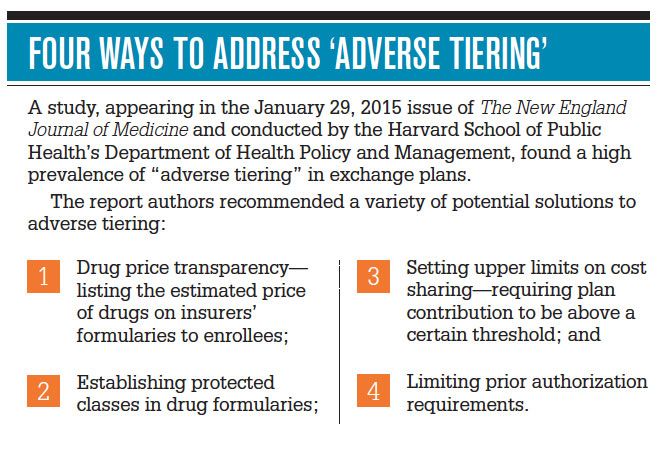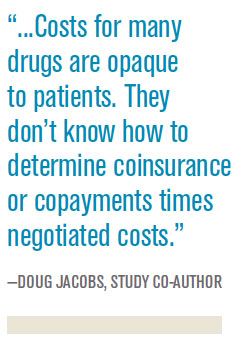Adverse tiering to deter costly patients comes under fire
Critics charge that the practice of adverse tiering to deter costly patients is violating the Affordable Care Act's coverage mandate.

When the Affordable Care Act (ACA) mandated that health plans accept all enrollees despite preexisting conditions or disabilities, the doors to health insurance coverage opened for millions of previously uninsured. But some insurers have found a way to get around the law.
The Office for Civil Rights, part of the Department of Health and Human Services (HHS), received a formal complaint in May 2014, from The AIDS Institute and the National Health Law Program alleging that some Florida insurers were offering exchange plans with formularies that placed both generic and branded HIV drugs on the highest cost tier.
The claim suggests that these insurers are using the tactic to deter people from enrolling in their plans, a far cry from the more common practice of putting expensive branded products on a higher tier to promote the use of generics.
NEXT: High prevalence of adverse tiering
High prevalence of adverse tiering
In January 2015, a study on “adverse tiering,” conducted by the Department of Health Policy and Management at the Harvard T.H. Chan School of Public Health, appeared in The New England Journal of Medicine. The study, which cited the complaint lodged by The AIDS Institute and the National Health Law Program, explored the prevalence of adverse tiering in 48 plans in 12 states offering a silver-level plan under the federal exchange. Six of those states had plans mentioned in the complaint, while the other six were the most populous states without any insurers in the complaint.

The study focused on a common class of HIV drugs-nucleoside reverse transcriptase inhibitors--and defined adverse tiering as putting drugs on a tier that called for at least 30% coinsurance or copayment. It identified 12 plans that fit the bill.
The 12 plans had an average annual cost of drugs more than triple those in non-adverse tiering plans. When analyzing other high-cost drugs--cancer, diabetes and rheumatoid arthritis--the study revealed that 52% of plans using adverse tiering required at least a 30% coinsurance for all coverage drugs in at least one class.
Study researchers suggest that many enrollees in adverse tiering plans will select another plan after a year once they are faced with paying extremely high out-of-pocket drug costs, potentially leading to adverse selection when sicker members choose non-adverse tiering plans.
Doug Jacobs with the Department of Health Policy and Management and coauthor of the study, says that pre-ACA, insurers could use higher premiums to deter enrollees but after passage of the law, which prevents insurers from discriminating based on pre-existing conditions, they have resorted to using tiering as a mechanism.
He says he was surprised by the high prevalence of adverse tiering and is concerned that as HIV drugs become too expensive, patients will stop taking them. “Right now costs for many drugs are opaque to patients,” Jacobs says. “They don’t know how to determine coinsurance or copayments times negotiated costs.”
NEXT: An exchange plan problem
An exchange plan problem

Mendelson“The problem of adverse tiering is most pronounced in the exchange plans,” says Dan Mendelson, chief executive officer of Avalere Health, an advisory company focused on healthcare business strategy and public policy. “Regrettably, health plans are not adequately compensated for providing to the sickest members. There is not incentive to seek out the highest risk patients so the result is to proactively put HIV on the highest tier and avoid having a tiering practice more generous than competitors.”
The solution is to have [the Centers for Medicare and Medicaid Services (CMS)]create a risk-adjusted framework that compensates for very ill patients. It could happen and cause competition,” he says. On the other hand, Mendelson notes that CMS failed to provide incentives to insurers to avoid raising medical costs. He is concerned that if drug costs rise too much, patients will abandon their medication at the point of sale.
Mendelson says that states could also mandate practices that create a level playing field for insurers through their exchange infrastructures, but he believes it is easier for the federal government to do so.
According to an analysis conducted by Avalere in February 2015, more than one-fourth of Qualified Health Plans (QHPs) placed all drugs in five classes, including HIV and cancer, on a specialty tier, while more than one-fifth charged 30% or more coinsurance for the same drugs. When considering four classes, more than 15% of QHPs required 40% coinsurance or more for drugs in those classes.
In addition, in 2015, QHPs are increasingly requiring a 30% coinsurance or higher for all single-source brands in a class. Managed Market Insights & Technology LLC, supplied the formulary data for the analysis.
NEXT: Insurers respond
Insurers respond
In November 2014, Aetna and other Florida insurers reached agreements with the Florida Office of Insurance Regulation to address some of the cost-tiering practices identified in the complaint lodged by The AIDS Institute and the National Health Law Program.
As part of the agreement, some insurers will lower cost sharing for HIV drugs for patients in the state served by QHPs in 2015.

Arnold“Aetna is changing the formularies for HIV drug coverage in our individual plans (nationwide for Aetna and Coventry individual products on and off the exchanges),” says Tammy Arnold, an Aetna spokesperson.
Effective June 1, 2015, all non-invasive, oral HIV medications will be classified on either the generic or non-preferred brand tiers on Aetna’s formularies, lowering patient cost sharing for these products to fixed dollar copayments of between $5 and $100 after applicable deductibles are met.
Other changes include:
- Keeping Fuzeon, a self-injectable, on the specialty tier because it requires greater care management;
- Placing new HIV drugs on the respective tier as they come to market (e.g. generic on the generic tier); and
- Providing member access to most HIV medications through either retail or mail channels with up to a 90-day supply.
“We made the change after an evaluation of our plans and coverage and will continue our ongoing evaluation of our plans and formularies to ensure they align with current standards of care and deliver the best value to our members,” Arnold says.
Cigna formerly required some patients on the exchange’s silver plan to contribute as much as 40% coinsurance for HIV drugs and limited access to some commonly used drugs by requiring prior authorization and placing 30-day supply limits.
In its agreement with Florida, Cigna will place a $200 a month limit on the amount that patients in the exchange will have to pay for prescribed HIV drugs, such as Atripla and Complera, effective for 2015 plans. All generic HIV drugs will move from a specialty to a generic tier and eliminate both prior authorizations and 30-day supply limits to ensure better access.
Humana lowered its 50% coinsurance to 10% for more costly HIV medications, and if those drugs cost less than $600, it lowers the cost to patients from 50% coinsurance to a $50 copayment.
The AIDS Foundation of Chicago and the AIDS Legal Council of Chicago also took Coventry Health Plan and Humana to task for charging more than $1,000 per month for several common HIV and AIDS medications for members on federal exchange plans.
The two organizations made their complaints known in a January 2015 letter to Coventry and Humana, along with Health Alliance and UnitedHealthcare, making them aware that their pricing strategies may come head-to-head with federal protection against discrimination.
Illinois does not regulate insurance coverage for people with HIV and AIDS, as Florida does, enabling the plans to charge high prices.
NEXT: Statute prescribes solution
Statute prescribes solution
HHS’ Notice of Benefit and Payment Parameters for 2016 states: “QHPs must not employ market practices or benefit designs that will have the effect of discouraging the enrollment of individuals with significant health needs.”
The statute requires that these limits be updated annually based on the percent increase in average per capita premiums for health insurance coverage, according to CMS.
Jacobs is confident that insurers will move ahead of the federal government’s new statute and develop standardized benefit design.
The Assembly Committee on Health, part of the California Assembly, approved bill (AB 339) recently to place limits on how much insurers can charge enrollees for outpatient prescriptions. The bill would cap costs at 1/24th of the annual out-of-pocket limit for a 30-day supply and require health plans to use specific formulary tiers.
Mari Edlin is a writer in Sonoma, California.
David Calabrese of OptumRx Talks New Role, Market Insulin Prices and Other Topics 'On His Mind'
April 13th 2023In this month’s episode of the "What's On Your Mind podcast," Peter Wehrwein, managing editor of MHE connects with the now Chief Clinical Officer of OptumRx Integrated Pharmacies, David Calabrese. In this conversation, David touches on his transition in January as OptumRx’s former chief pharmacy officer and market president of health plans and PBMs to his new role as Chief Clinical Officer where he now focuses more on things such as specialty pharmacy to home delivery — with an overall goal of creating whole-patient care. Throughout the conversation, Calabrese also touched on the market’s hot topic of insulin prices and behavioral health services within the OptumRx community, among other topics.
Listen
Briana Contreras, editor of Managed Healthcare Executive, spoke with Nancy Lurker, CEO and president of EyePoint Pharmaceuticals. Nancy shared a bit about EyePoint and how the organization’s innovative therapies are addressing patient needs through eye care, and most importantly, she addressed C-Suite positions like the CEO role. Nancy shared advice for those seeking to reach the CEO level, especially toward women in healthcare and other roles, and what it takes to run a biopharma company.
Listen